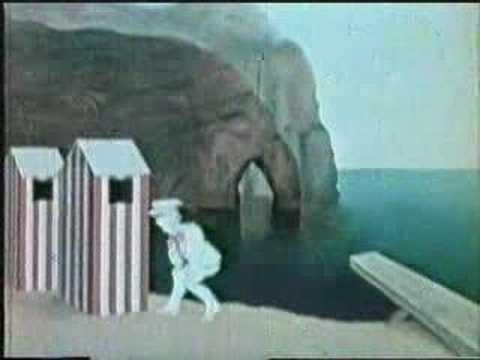
The "Reynaud films" are the work of pioneering animator Charles-Émile Reynaud.
The concept of persistence of vision, and the idea that a succession of flashing images could produce the illusion of motion, had been understood for much of the 19th century. By the 1830s the zoetrope![]() had been invented. The zoetrope was a crude animation device consisting of a drum with images on the inside and slits in the side, causing the appearance of motion when one spun the drum and looked through the slits. In 1878 Reynaud had improved on this by inventing the praxinoscope
had been invented. The zoetrope was a crude animation device consisting of a drum with images on the inside and slits in the side, causing the appearance of motion when one spun the drum and looked through the slits. In 1878 Reynaud had improved on this by inventing the praxinoscope![]() , which replaced the slits with an inner wheel of mirrors, making for a better image. Reynaud later added a lantern which allowed for projection of the images onto a screen. Unfortunately both devices were limited to 12 images, allowing only short and very crude animation.
, which replaced the slits with an inner wheel of mirrors, making for a better image. Reynaud later added a lantern which allowed for projection of the images onto a screen. Unfortunately both devices were limited to 12 images, allowing only short and very crude animation.
In 1888 Reynaud had made a breakthrough. He hit upon the idea of creating belts of glass-painted images, with holes in the belt that allowed for a wheel with spokes to move the belt through the projector. This invention, which resembled the later invention of motion picture projectors, allowed for Reynaud to project longer and more complex cartoons, with 500 or more images on glass plates. The cartoons ran for anywhere from 5 to 15 minutes, depending on projection speed.
Reynaud first exhibited his new cartoons for the public in 1892. These were some of the first exhibitions of motion pictures in the world, beating the Lumiere brothers and their live-action films to the punch by a full three years. Reynaud's cartoons became quite popular, but his technique of reflecting glass plates proved to be a technological dead end, soon eclipsed by the Lumiere brothers and Thomas Edison and others who were projecting motion pictures by using photographic film. Real Life had a downer ending when Reynaud, depressed over his declining career, threw almost all of his cartoons into the Seine in 1910. Only two survive and they add up to about a five-minute run time. They are:
- Pauvre Pierrot (Poor Pierrot) (1892) — Harlequin and Pierrot compete for the affections of beautiful Columbine
- Autour d'une cabine (Around a Cabin) 1894 — A couple go swimming at the beach, only to be bothered by a dirty old man who harasses the wife
Tropes:
- Beach Episode: Autour d'une cabin takes place at the seaside—the cabin is a beach hut.
- Behind a Stick: Harlequin somehow hides behind a thin marble column. This would become one of the most well-known tropes in animation.
- Butt-Monkey: Pierre. Not only does Harlequin win the affections of Colombine and annoy Pierrot into leaving, he steals Pierrot's bottle of booze.
- Dirty Old Man: The Peeping Tom at the beach is clearly an older man, with a bushy white mustache.
- The End: After the lovers swim away from the beach, a man in a rowboat comes out and unfurls a sail that says "LA REPRESENTATION EST TERMINEE".
- Liquid Courage: Pierrot, who gave Colombine a bouquet and left, comes back drunk (he is repeatedly hoisting a bottle), and tries the Serenade Your Lover gambit.
- Literal Ass-Kicking: The male companion kicks the old man in the butt when he catches him peeping.
- Love Triangle: In Pauvre Pierrot, between Colombine and her suitors Pierrot and Harlequin.
- The Peeping Tom: The woman's companion catches the Dirty Old Man trying to peep into her beach hut.
- Serenade Your Lover: Pierrot tries this, but Colombine doesn't even come out to the balcony.
